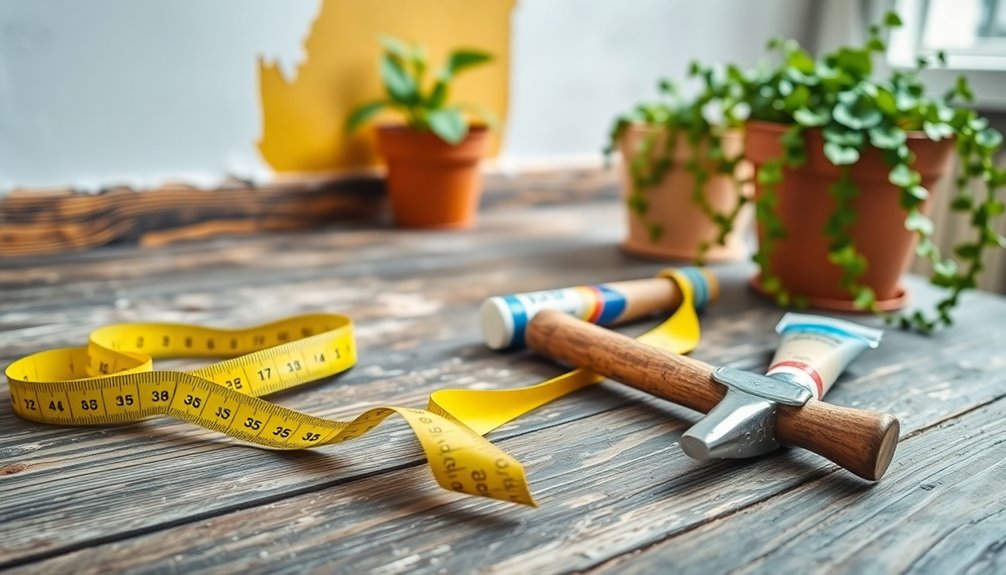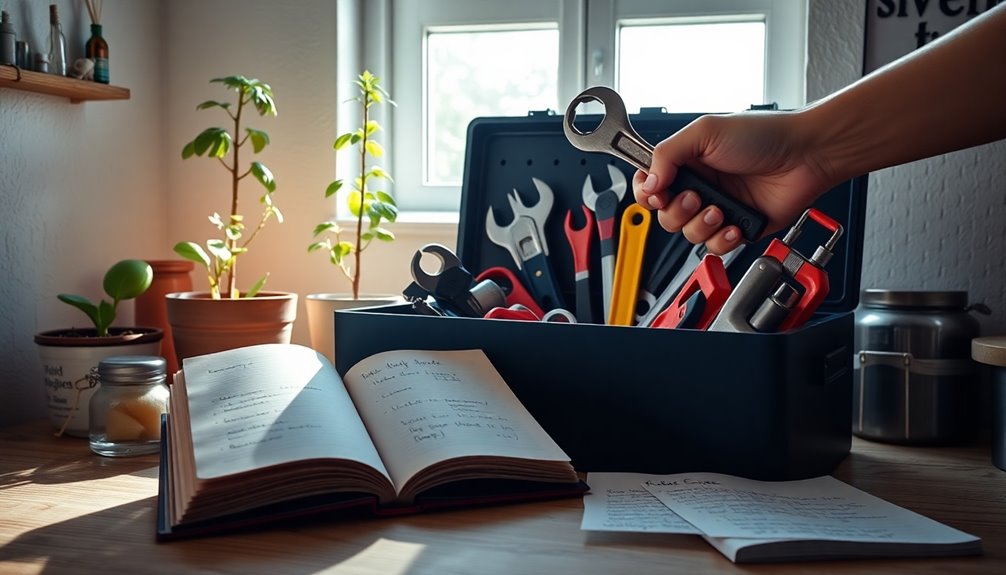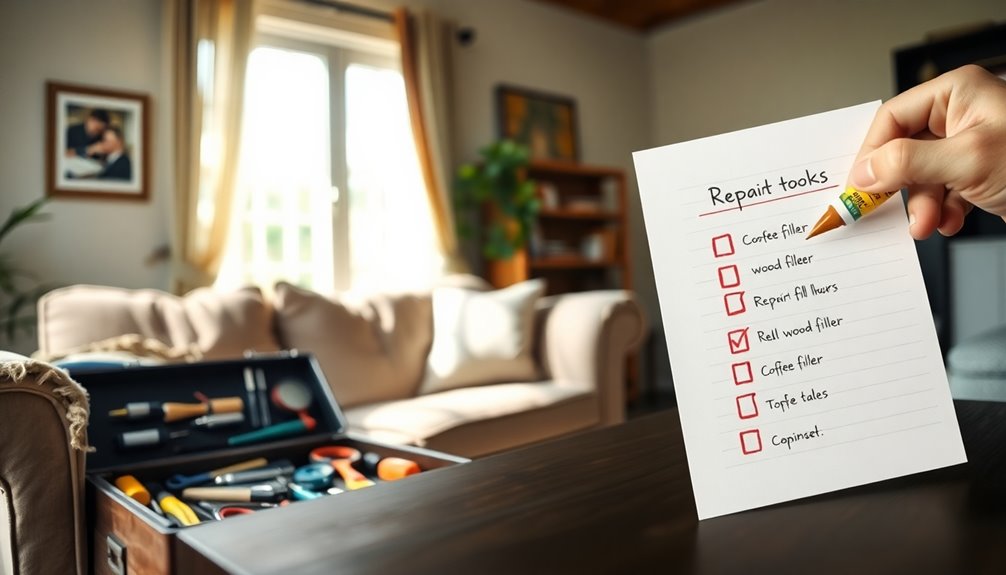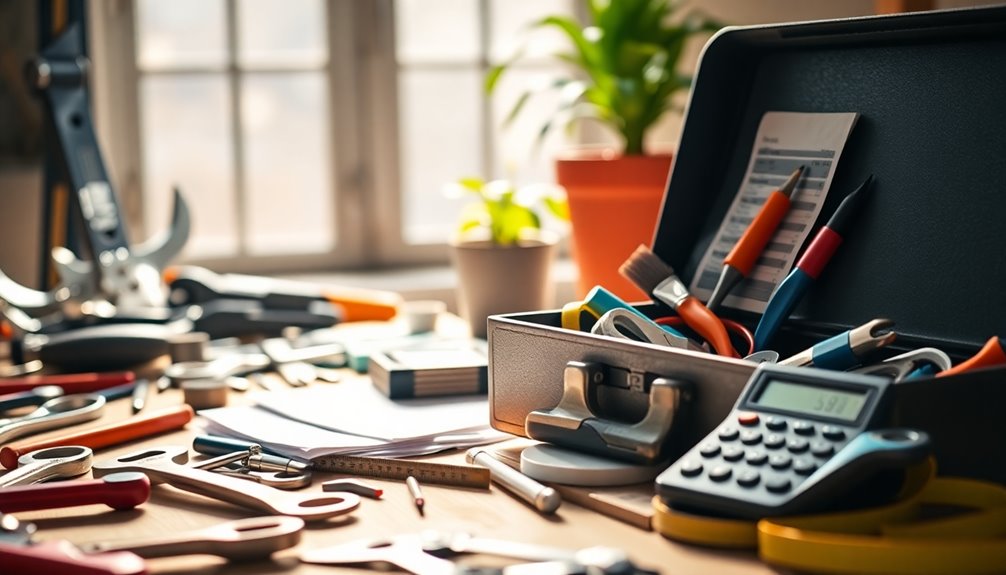You can save money on home repairs with a few simple tips. Start by tackling easy DIY tasks like fixing leaky faucets or unclogging drains. Regular preventative maintenance, such as cleaning gutters and checking electrical wiring, can prevent costly problems down the line. Prioritize urgent repairs to avoid escalating costs; document them to stay organized. Utilize online resources for step-by-step guides and materials at a discount. If larger fixes are needed, consider financing options like personal loans or home equity. There's plenty more to uncover about making your home repairs budget-friendly.
Key Takeaways
- Perform simple DIY repairs like fixing leaky faucets or unclogging drains to save on labor costs.
- Prioritize preventative maintenance to catch issues early and avoid costly repairs.
- Use online resources for step-by-step guides and budget planning to manage repair expenses.
- Document and prioritize urgent repairs to address critical issues before they escalate.
- Explore financing options like home equity loans or credit cards with 0% APR for larger projects.
Identify High-Labor-Cost Projects

When you're tackling home repairs, it's crucial to identify projects that involve high labor costs, as these can significantly impact your budget.
Roof repairs are often at the top of the list, with labor making up 60-70% of costs. Foundation repairs also demand skilled labor, costing between $250 and $800 per crack. Additionally, the costs associated with mold removal can add up quickly, making it essential to address any issues promptly to avoid escalating expenses. Regular maintenance of home systems, such as heat pumps, can prevent costly breakdowns and repairs.
Plumbing and electrical work can be equally costly, with labor accounting for 20-25% of total expenses, while safety risks make hiring professionals essential.
Mold remediation requires specialized skills too, with labor costs ranging from 50-70%.
Simple DIY Repairs

While many homeowners might feel intimidated by repairs, simple DIY tasks can save you both time and money.
For instance, fixing a leaky faucet takes just 30 minutes and requires a wrench, plumber's tape, and a replacement washer. Common issue for homeowners, this repair can prevent water wastage and reduce your utility bill. Additionally, addressing such issues early can help maintain your credit score by preventing larger, costlier repairs down the line.
Unclogging drains can be handled with a drain snake and a mix of vinegar and baking soda.
Patching drywall holes is easy with spackle and a putty knife, while painting your walls only requires primer, paint, and brushes.
Replacing a light switch or fixing a running toilet can also be done quickly with minimal tools.
Finally, caulking gaps in windows or doors is straightforward and saves on professional services.
Embrace these tasks to keep your home in shape and your wallet happy!
Preventative Maintenance

Taking care of simple DIY repairs helps maintain your home, but preventative maintenance is what truly keeps costly issues at bay.
Start by conducting monthly inspections, like replacing HVAC filters and checking your carbon monoxide detectors. Regularly clean your gutters to prevent water damage and inspect electrical wiring for wear. Additionally, regular maintenance can enhance the lifespan of your home systems and appliances, supporting a healthier lifestyle by promoting cleanliness and hygiene.
Seasonal tasks, such as preparing your heating system for winter or inspecting your roof for damage, are essential too.
Don't forget to schedule annual professional inspections for your HVAC and appliances to catch potential problems early.
Prioritizing Immediate Needs

To effectively manage home repairs, start by identifying the most pressing issues that could compromise your safety or the functionality of your home.
Focus on urgent repairs like leaks, electrical problems, or structural issues. Check major systems such as plumbing and HVAC to ensure they're functioning correctly, and inspect for water damage, which can escalate quickly. Additionally, consider conducting a thorough inspection to spot any underlying problems that may not be immediately apparent, as some issues, like nail diseases, can indicate larger health concerns if not addressed.
Prioritize immediate threats, like broken windows or leaky pipes, and consider how repairs impact your daily life—like a non-functional toilet.
Be mindful of your budget, addressing essential repairs first. Document your findings to track progress, and create a priority list to categorize tasks by urgency.
Regularly review this list to adapt as circumstances change, ensuring critical needs are always met first.
Using Online Resources

When you tap into online resources, you can significantly cut costs on home repairs while gaining valuable skills.
Websites like Family Handyman offer step-by-step guides and video tutorials for tasks such as fixing leaky faucets or unclogging toilets. You can also join community forums to ask questions and gather insights from other homeowners. Additionally, many platforms provide insights on budget-friendly DIY projects that can save you even more money.
For budget planning, sites like Bankrate provide cost estimates for various DIY projects. Additionally, look for discounts on materials through online classifieds and manufacturer websites to find the best deals. Researching the cost-effectiveness of repairs versus replacements online helps you identify cheaper options, while expert advice can guide you on when to tackle a project yourself or seek professional help.
Use these resources to your advantage!
Financing Options

How can you fund those unexpected home repairs without breaking the bank? Consider home equity loans or lines of credit for lower interest rates and higher loan amounts. They can cover significant expenses, and the interest might even be tax-deductible. Additionally, you may find that long-term financial planning can help you manage these costs over time.
If you're looking for quick access, personal loans offer fast approval without collateral, though they usually come with higher interest rates. In urgent situations, personal loans can provide the necessary funds for immediate repairs without the lengthy approval process associated with secured loans.
Cash-out refinancing can lower monthly payments and simplify your finances by combining loans, but watch out for higher closing costs.
Lastly, credit cards with 0% APR for a limited time can be great for smaller projects, but be cautious of potential high fees and interest rates after the promotional period ends.
Choose the option that fits your needs best!
Frequently Asked Questions
What Tools Are Essential for DIY Home Repairs?
For DIY home repairs, you'll need a solid set of tools.
Start with a screwdriver set and pliers for basic tasks. A hammer and tape measure are essential for accuracy.
Don't forget a cordless drill for versatility! A circular saw will help with cutting materials, while a power sander smooths surfaces.
Safety gear, like glasses and gloves, is crucial too.
Having these tools on hand makes tackling repairs much easier and more efficient.
How Can I Budget for Unexpected Home Repair Costs?
To budget for unexpected home repair costs, start by assessing your home's condition and identifying potential issues.
Set aside 1% to 3% of your home's value annually, and consider monthly contributions to build a repair fund.
Prioritize urgent repairs first, and regularly review your budget to accommodate any changes.
What Are the Best Materials for DIY Projects?
When you're diving into DIY projects, choosing the right materials is crucial.
You can't go wrong with MDF for its versatility and cost-effectiveness. Solid wood offers durability and aesthetic appeal but can be pricier.
Particleboard is affordable and easy to work with, while hardboard provides strength for various applications.
Lastly, don't overlook insulation; it's essential for energy efficiency and can be a straightforward DIY task.
Consider your project's needs to make the best choice!
How Do I Know if a Project Is Too Complex?
Ever felt overwhelmed by a project's sheer size or the number of people involved?
When you're assessing complexity, consider factors like team size, unclear objectives, and external dependencies. If the project's got many moving parts or requires precise execution, it's likely too complex.
Keep an eye on changing requirements and resource availability, too. If it starts feeling chaotic, it might be time to simplify or rethink your approach.
Can I Hire a Professional for Part of a DIY Project?
Yes, you can hire a professional for part of a DIY project.
It's smart to recognize your limits. If you encounter a complex task or safety issue, bringing in an expert can save you time and potential headaches.
You might handle the simpler tasks and let a pro tackle the more challenging aspects.
Just ensure you communicate clearly about what you want them to do and maintain a collaborative approach throughout the project.
Conclusion
By identifying high-labor-cost projects, tackling simple DIY repairs, and practicing preventative maintenance, you can save money and stress. Prioritizing immediate needs, utilizing online resources, and exploring financing options will empower you to manage home repairs effectively. Remember, being proactive and informed not only keeps your home in shape but also keeps your wallet happy. So, embrace these tips, stay ahead of repairs, and watch your savings grow while maintaining a comfortable home.









